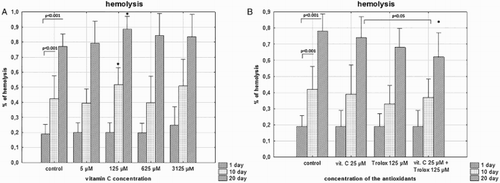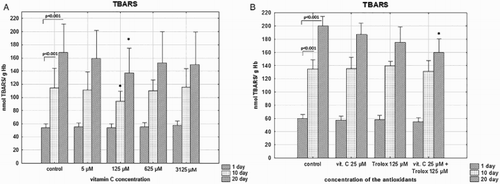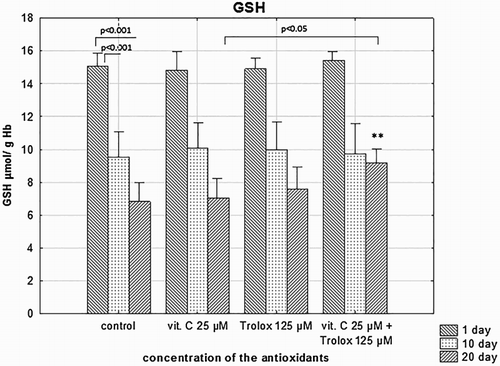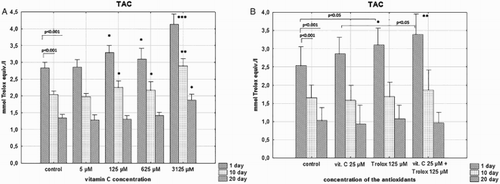Figures & data
Figure 1. The effects of the RBC storage in the presence of vitC (a) or vitC and Trolox (b) on the degree of hemolysis. The results shown are means ± SD of eight independent experiments (n = 8), where n means number of donors; *p < .05 in the presence of antioxidant (antioxidants) at any given day of storage versus in the absence of antioxidants (control) at the appropriate day of storage. The significance of differences between the mean values of various parameters were analyzed by one-way analysis of variance (ANOVA) with Bonferroni correction (Bonferroni post hoc test) (a). The differences between the groups (the mean values of SA (25 μM), Trolox (125 μM) and the combination of SA/Trolox samples) were analyzed by the non-parametric Wilcoxon test (b).

Figure 2. The effects of the RBC storage in the presence of vitC (a) or vitC and Trolox (b) on the extracellular LDH activity. The results shown are means ± SD of eight independent experiments (n = 8), where n means number of donors; *p < .05 in the presence of antioxidant (antioxidants) at any given day of storage versus in the absence of antioxidants (control) at the appropriate day of storage. The significance of differences between the mean values of various parameters were analyzed by one-way analysis of variance (ANOVA) with Bonferroni post hoc test (a). The differences between the groups (the mean values of SA (25 μM), Trolox (125 μM) and the combination of SA/Trolox samples) were analyzed by the non-parametric Wilcoxon test (b).

Figure 3. The effects of the RBC storage in the presence of vitC (a) or vitC and Trolox (b) on the TBARS concentration. The results shown are means ± SD of eight independent experiments (n = 8) where n means number of donors; *p < .05 in the presence of antioxidant (antioxidants) at any given day of storage versus in the absence of antioxidants (control) at the appropriate day of storage. The significance of differences between the mean values of various parameters were analyzed by one-way analysis of variance (ANOVA) with Bonferroni post hoc test (a). The differences between the groups (the mean values of SA (25 μM), Trolox (125 μM) and the combination of SA/Trolox samples) were analyzed by the non-parametric Wilcoxon test (b).

Figure 4. The effects of the RBC storage in the presence of vitC and Trolox on the GSH depletion. The results shown are means ± SD of eight independent experiments (n = 8), where n means number of donors; **p < .01 in the presence of antioxidants at day 20 versus in the absence of antioxidants (control) at the 20 day of storage. The differences between the groups (the mean values of SA (25 μM), Trolox (125 μM) and the combination of SA/Trolox samples) were analyzed by the non-parametric Wilcoxon test.

Figure 5. The effects of the RBC storage in the presence of vitC (a) or vitC and Trolox (b) on TAC in the supernatant. The results shown are means ± SD of eight independent experiments (n = 8), where n means number of donors; *p < .05, **p < .01, ***p < .001 in the presence of antioxidant (antioxidants) at any given day of storage versus in the absence of antioxidants (control) at the appropriate day of storage. The significance of differences between the mean values of various parameters were analyzed by one-way analysis of variance (ANOVA) with Tukey’s post hoc test (a). The differences between the groups (the mean values of SA (25 μM), Trolox (125 μM) and the combination of SA/Trolox samples) were analyzed by the non-parametric Wilcoxon test (b).

